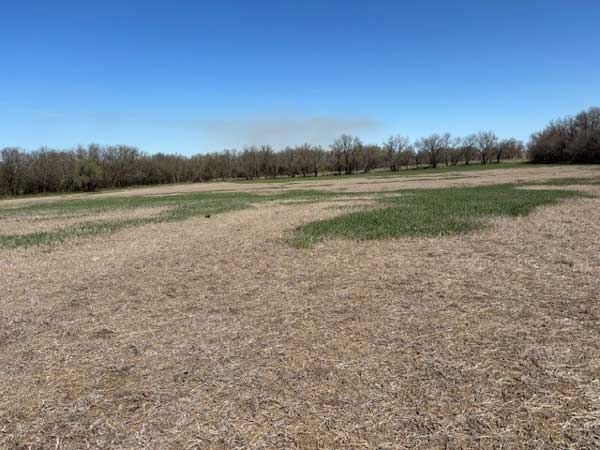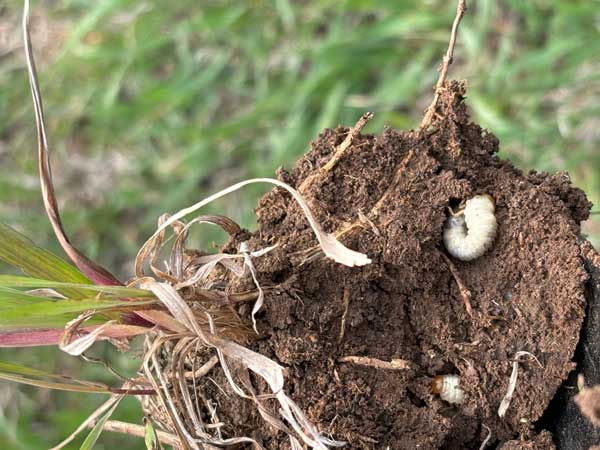White grubs, the larvae of beetles commonly known as May beetles and June beetles, can be pests of many different commodities. Dead patches in brome fields in Kansas have recently been reported (Figure 1). The sizes of the dead patches varied across affected fields, but in all cases, white grubs could easily be found in soil when collecting samples from the areas (Figure 2). This strongly indicates that the white grubs are responsible for the observed dead zones.

Figure 1. Brome field in Butler County, KS with dead patches from white grubs. Photo by Charlene Miller, K-State Research and Extension.

Figure 2. White grubs in soil taken from a brome field. Photo by Charlene Miller, K-State Research and Extension.
These beetle larvae are belowground pests, feeding on root systems, and can impact a field for several seasons as they take three years to mature fully. Eggs are laid in the spring when adult beetles are attracted to fields. After hatching, the tiny grubs will feed on roots all season long. This first season of feeding often goes completely unnoticed due to the small size of the larvae, which prevents significant root damage. When the soil cools off in the fall, the larvae, now larger from a season of feeding, descend into the soil profile and overwinter there. The following spring, as soil temperatures increase, the larvae move up into the root zone of the field and commence feeding. It is during this second season of feeding that damage can become apparent. The larger size of the grubs means that more root tissue can be consumed faster. So, when white grub populations are large enough, it can lead to the appearance of dead spots in brome fields like those being observed this spring.
Feeding will continue this season, and the grubs will once again overwinter in the soil at the end of the fall. Next spring, feeding damage should be minimal as grubs are nearing maturity and will stop feeding to create an earthen chamber in which they will finish development and emerge as adult beetles the following year.
Options for damaged fields
With the damage already done this year, what can be done about the dead spots? Depending on the extent of the damaged area, there are a couple of potential options. Replanting the dead areas could be considered if losses are not extreme. Replanting brome in the fall would give the plants time to develop a stronger root system to minimize grub damage the following spring when they resume feeding. Before replanting, treatment of the areas with carbaryl could help reduce the grub population, but this option is not guaranteed to solve the problem as older grubs are less susceptible. It is important to get the insecticide carried into the soil profile where the grubs are more likely to come in contact; surface application will be ineffective, especially if the area is covered with dead vegetation.
In situations where losses are very large, replanting to something else is an option. If this is done, the remaining brome and any other live plants should be destroyed at least 2 to 4 weeks before planting. To reduce injury from remaining grubs, the seed should be treated with an insecticidal seed treatment, and a planting-time insecticide application might be considered.
A replanting option could be a summer annual forage crop. Where most of the brome is dead, kill off the remaining brome with glyphosate and plant a summer annual around June 1. Alternative summer annuals to consider are sudangrass, a sorghum-sudan hybrid, or pearl/foxtil millet. Information regarding these summer annuals can be found in MF2871 Summer Annual Forages: Selection and Production Characteristics. The summer annuals can be grazed or hayed. One concern may be environmental stress. These species can all accumulate nitrates if the weather is dry. Prussic acid could be another issue with the sorghum species. Prussic acid is not an issue if a millet is planted. After utilizing the summer annual, smooth brome could be seeded in the late summer to fall time period. The optimum time for seeding brome varies a little across Kansas, but August 20 to September 15 usually works well. Information regarding seeding and establishment of smooth brome can be found in C402 Smooth Brome Production and Utilization.
Anthony Zukoff, Extension Entomology Associate – Garden City
azukoff@ksu.edu
Walt Fick, Extension Rangeland Management Specialist
whfick@ksu.edu
Tags: pastures replanting brome grubs grub worms